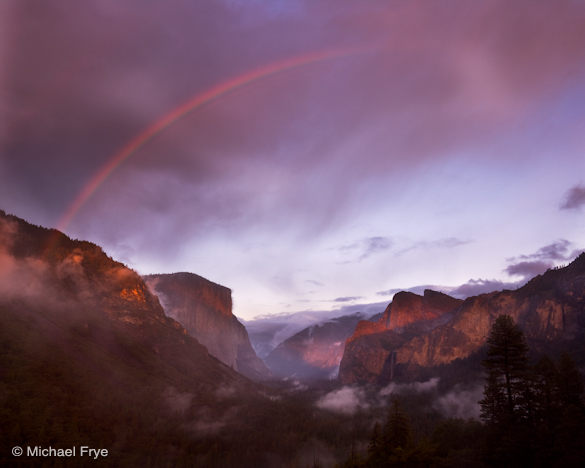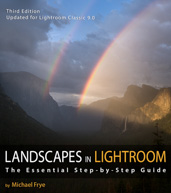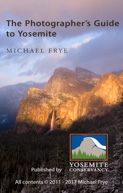by Michael Frye | Sep 12, 2009 | Yosemite Photo Conditions

Rainbow over Yosemite Valley from Tunnel View, October 4th, 2008
As the days get shorter and cooler, the photo opportunities in the Yosemite area get hotter. It’s time to take a look at what to expect during the next few months.
September
 You won’t find much autumn color in Yosemite before October, but the indian rhubarb in Bridalveil and Leidig Meadows can add an early splash of yellow, as in this photo from the west end of Leidig. Near the fall equinox on September 22nd, and for a couple of weeks afterward, the sun sets at a good angle for Tunnel View, lighting both El Capitan on the left and Cathedral Rocks on the right. The two or three weeks before the spring equinox are even better, as there’s usually water in Bridalveil Fall, but fall can be great in the right weather conditions, like last year when I saw the rainbow at the top of this post.
You won’t find much autumn color in Yosemite before October, but the indian rhubarb in Bridalveil and Leidig Meadows can add an early splash of yellow, as in this photo from the west end of Leidig. Near the fall equinox on September 22nd, and for a couple of weeks afterward, the sun sets at a good angle for Tunnel View, lighting both El Capitan on the left and Cathedral Rocks on the right. The two or three weeks before the spring equinox are even better, as there’s usually water in Bridalveil Fall, but fall can be great in the right weather conditions, like last year when I saw the rainbow at the top of this post.
On the east side of the Sierra Nevada the high-elevation aspens usually start turning yellow in late September. The Bishop Creek area, west of Bishop, and Convict Lake, just south of Mammoth Lakes, are two of the early season hot spots. The road to Virginia Lakes, north of Lee Vining, can also have early fall color.
October
 In a typical year, the aspen color show progresses down the mountainsides on the east side of the range and reaches the lowest elevations near the third week of October. There’s no real peak, because the timing of the best color depends on the location. I prefer photographing the larger trees at lower elevations, so the third week is often my favorite time, but there’s usually plenty to photograph earlier in the month as well. Some of my favorite spots are Lundy Canyon, Lee Vining Canyon (right), and the June Lake Loop.
In a typical year, the aspen color show progresses down the mountainsides on the east side of the range and reaches the lowest elevations near the third week of October. There’s no real peak, because the timing of the best color depends on the location. I prefer photographing the larger trees at lower elevations, so the third week is often my favorite time, but there’s usually plenty to photograph earlier in the month as well. Some of my favorite spots are Lundy Canyon, Lee Vining Canyon (right), and the June Lake Loop.
The maples, dogwoods, cottonwoods, and oaks in Yosemite Valley usually turn a bit later. The peak color typically arrives around the end of October or beginning of November. Dogwoods can can often be found turning gold or even red by mid-October at higher elevations along Highway 41, Highway 120 west of Crane Flat, and in the Tuolumne Grove.
Blueberry bushes lining the shores of Siesta Lake along the Tioga Pass Road also turn red and orange near the middle of the month (below). From Taft Point, a one-mile hike from the Glacier Point Road, the late-afternoon sun strikes El Capitan at a great angle.

November
This might be my favorite month in Yosemite Valley. The peak autumn color frequently arrives at the beginning of the month and yellow and gold leaves often linger for weeks afterward. Frost and ice begin forming in the meadows and along the creeks and rivers, and sometimes an early snowfall spices up the landscape. Sunlight has already reached winter angles, raking across the face of Half Dome in the late afternoon and turning El Capitan gold at sunset.
For more detailed information, including directions to most of the locations mentioned here, pick up a copy of my book The Photographer’s Guide to Yosemite.
Addendum, September 2011: Now The Photographer’s Guide to Yosemite is available as an iPhone app!
by Michael Frye | May 9, 2009 | Photography Tips, Yosemite Photo Conditions
 Last night I joined the throngs in Cook’s Meadow to photograph the lunar rainbow on Upper Yosemite Fall. There were at least 100 photographers around the meadow, and probably many more at the bridge below Lower Yosemite Fall. Like Horsetail Fall in February, lunar rainbows have become a photographic phenomenon. Until recently the most popular place was at Lower Yosemite Fall, but since Don Olson published specific times for seeing the “moonbow” from the Sentinel Bridge in Cook’s Meadow this spot has attracted lots of photographers. The big advantage is that it’s dry! At the bridge below Lower Yosemite Fall it’s impossible to keep mist off the front of the lens.
Last night I joined the throngs in Cook’s Meadow to photograph the lunar rainbow on Upper Yosemite Fall. There were at least 100 photographers around the meadow, and probably many more at the bridge below Lower Yosemite Fall. Like Horsetail Fall in February, lunar rainbows have become a photographic phenomenon. Until recently the most popular place was at Lower Yosemite Fall, but since Don Olson published specific times for seeing the “moonbow” from the Sentinel Bridge in Cook’s Meadow this spot has attracted lots of photographers. The big advantage is that it’s dry! At the bridge below Lower Yosemite Fall it’s impossible to keep mist off the front of the lens.
You can’t really see a lunar rainbow with the naked eye. Our eyes don’t render color very well in the dark, so at best you can see a bright arc and maybe a hint of color. But the color is there, and film or digital sensors capture it well. One of the reasons that more people haven’t photographed lunar rainbows from Cook’s Meadow in the past is that you can’t really see it from there. With film you’d just have to guess about the position and wait to find out whether you were right. With digital sensors it’s easy to just take a photo and see the position of the rainbow.
Last night the moon was bright enough that I could see the rainbow fairly well. Along with everyone else I watched it move down the fall as the moon rose. When the rainbow fell too low, most people packed up (it was 11:30 p.m. after all), but I followed the moon westward and saw an even more vivid rainbow from near the Yosemite Chapel. This photograph was made from that spot. Rainbows form a circle around a spot opposite the light source—sun or moon. Lunar rainbows can be seen on any waterfall that gets moonlight if you position yourself properly. In fact I photographed a lunar rainbow on Castle Geyser in Yellowstone many years ago. Maybe I’ll put that image in another post.
Long exposures with digital cameras can create lots of noise, but newer models handle this pretty well. You’re usually better off making a long exposure at a low ISO than a shorter exposure with a higher ISO. But with lunar rainbows you don’t want to make the exposure too long or the bands of color will blend together. I used a six-minute exposure at f/4 and 100 ISO for the image above. Trying to lighten a dark image will exaggerate noise, so it’s best to make the photograph as light as possible without overexposing it. Don’t rely on just how it looks on your LCD screen. Since it’s dark, the screen will look bright even if the image is underexposed. Use your histogram.
Having said that, a nighttime photograph shouldn’t be too bright. You don’t want it to look like it was taken under midday sunlight. I actually darkened this image—especially the sky—in software to give it more of a nighttime feeling.
 You won’t find much autumn color in Yosemite before October, but the indian rhubarb in Bridalveil and Leidig Meadows can add an early splash of yellow, as in this photo from the west end of Leidig. Near the fall equinox on September 22nd, and for a couple of weeks afterward, the sun sets at a good angle for Tunnel View, lighting both El Capitan on the left and Cathedral Rocks on the right. The two or three weeks before the spring equinox are even better, as there’s usually water in Bridalveil Fall, but fall can be great in the right weather conditions, like last year when I saw the rainbow at the top of this post.
You won’t find much autumn color in Yosemite before October, but the indian rhubarb in Bridalveil and Leidig Meadows can add an early splash of yellow, as in this photo from the west end of Leidig. Near the fall equinox on September 22nd, and for a couple of weeks afterward, the sun sets at a good angle for Tunnel View, lighting both El Capitan on the left and Cathedral Rocks on the right. The two or three weeks before the spring equinox are even better, as there’s usually water in Bridalveil Fall, but fall can be great in the right weather conditions, like last year when I saw the rainbow at the top of this post. In a typical year, the aspen color show progresses down the mountainsides on the east side of the range and reaches the lowest elevations near the third week of October. There’s no real peak, because the timing of the best color depends on the location. I prefer photographing the larger trees at lower elevations, so the third week is often my favorite time, but there’s usually plenty to photograph earlier in the month as well. Some of my favorite spots are Lundy Canyon, Lee Vining Canyon (right), and the June Lake Loop.
In a typical year, the aspen color show progresses down the mountainsides on the east side of the range and reaches the lowest elevations near the third week of October. There’s no real peak, because the timing of the best color depends on the location. I prefer photographing the larger trees at lower elevations, so the third week is often my favorite time, but there’s usually plenty to photograph earlier in the month as well. Some of my favorite spots are Lundy Canyon, Lee Vining Canyon (right), and the June Lake Loop.










